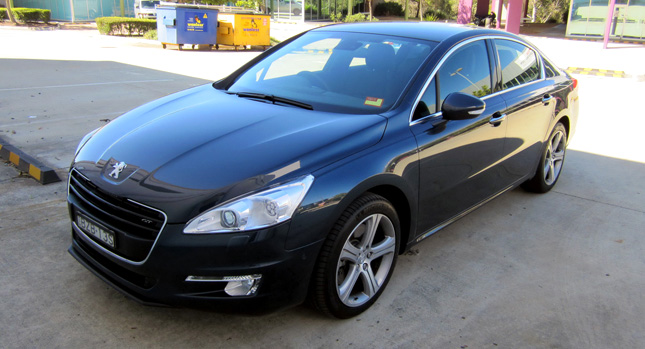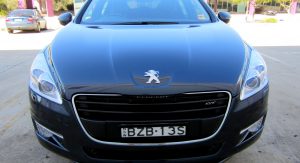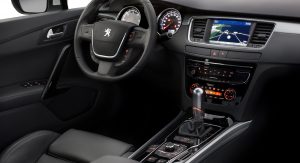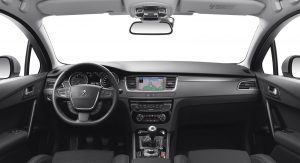It’s been a long time since Peugeot had a serious contender in the hotly contested sub-premium segment. The 407 was unloved and lacking in style; a “307 with a boot” purchased exclusively by the brand faithful. It was a bit bland and outdated compared to its major European competitor: the Mk 4 Ford Mondeo.
 With the 508, Peugeot hopes to change all that. A carbon copy of the Peugeot 5 Concept that premiered at the 2010 Geneva Motor Show, the 2011 Peugeot 508 puts the verve – that oh-so-important French flair – back into Peugeot’s line-up.
With the 508, Peugeot hopes to change all that. A carbon copy of the Peugeot 5 Concept that premiered at the 2010 Geneva Motor Show, the 2011 Peugeot 508 puts the verve – that oh-so-important French flair – back into Peugeot’s line-up.
We take the wheel of Peugeot’s flagship, AU$52,990 508 GT with a 2.2-liter turbocharged diesel and a 6-speed automatic for a week-long road test and review.
Overview
 Like the Peugeot 5 Concept, the 508 is guaranteed to polarise opinions. The styling definitely falls into the like it or loath it category with a Bangle-esque arse, 7th generation Honda Accord headlights, trapezoidal grille and reverse rake C-pillar. Somehow, though, it all works – especially in the flesh.
Like the Peugeot 5 Concept, the 508 is guaranteed to polarise opinions. The styling definitely falls into the like it or loath it category with a Bangle-esque arse, 7th generation Honda Accord headlights, trapezoidal grille and reverse rake C-pillar. Somehow, though, it all works – especially in the flesh.
There’s a sense of style and occasion to the 508, and the GT spec’s 18 inch alloys really set the car off. The clustered daytime running lights, front fogs and the subtle use of chrome on the boot lid, grille and around the window line are also effective.
It compares favourably when placed alongside its competitors: the Ford Mondeo, Honda Accord Euro, Hyundai i45 / Sonata and Volkswagen Passat. The 508 sedan measures 4,792 mm (188.66 in.) in length with a 2,817 mm (110.90 in.) wheelbase – roughly 100 mm (3.93 in.) less than the current gen Holden Commodore sedan.
The front and rear overhangs are well proportioned at 985 mm (38.77 in.) and 990 mm (38.98 in.) respectively. It’s also 1,456 mm (57.32 in.) tall and 2,068 mm (81.42 in.) wide with the wing mirrors (1,853 mm / 72.95 in. without). It’s very individual and very French, which I think is just what the designers were going for.
Inside Scoop
 Inside is where the 508 really shines. The seats are Nappa leather and the cabin abounds with piano black and carbon-lookalike trim pieces. What surprises most is just how functional everything is: from the intuitive quad-zone climate control to the meaty multi-function steering wheel.
Inside is where the 508 really shines. The seats are Nappa leather and the cabin abounds with piano black and carbon-lookalike trim pieces. What surprises most is just how functional everything is: from the intuitive quad-zone climate control to the meaty multi-function steering wheel.
The instrument cluster is neatly designed and easy to read, as is the switchable trip computer display. The colour HUD is less useful, being all but unreadable in direct sunlight and with no option to turn it off [Update: turns out it can be turned off, see note below].
On the upside, the satellite navigation and radio controls are some of the best on the market and a pleasure to use. The front pews are also comfortable and there’s more than enough leg room, even for a tall bloke like me.
On The Road
 Our Egyptian Blue 508 GT was fitted with Peugeot’s 2.2-liter HDi four-cylinder common rail turbo diesel engine producing an output of 204HP / 150 kW at 3,500 rpm and a peak torque of 450 Nm / 331.9 lb-ft at 2,000 rpm.
Our Egyptian Blue 508 GT was fitted with Peugeot’s 2.2-liter HDi four-cylinder common rail turbo diesel engine producing an output of 204HP / 150 kW at 3,500 rpm and a peak torque of 450 Nm / 331.9 lb-ft at 2,000 rpm.
The turbocharged diesel is a torquey little unit and well-paired to the 6-speed automatic transmission that powers the front-wheels, allowing for both comfortable freeway cruising and brisk overtaking manoeuvres.
Peugeot’s published figures suggest a 0 to 100 km/h (0 to 62mph) time of 8.2 seconds; I think most drivers (myself included) would manage 9 without pushing the engine too hard. We were unable to test the claimed 230 km/h (145 mph) top speed, though at 100 km/h (62 mph) the HDi was suitably quiet and refined.
It’s easy to forget just how large a car it really is, except when parking it – at which point the front and rear parking sensors become a real godsend.
I wasn’t impressed with the GT’s unique double wishbone and drop link hub carrier front suspension, which let me feel and hear every bump and pothole on the road. I understand that there’s an expectation for all car’s today to have some sporting character but in this category I’d rather have a little less sport and a little more comfort.
The weighted steering is also good in a variety of conditions, thanks mostly to the speed sensitive power steering. I’ve yet to find a large car that’s as much a pleasure to park as the 508. The steering wheel mounted cruise control and speed limiter functions are also very intuitive and make driving the 508 a real treat.
As for fuel economy, I think the manufacturer’s combined cycle rating of 5.7 lt/100 (41.2 mpg US, 49.6 mpg UK ) is a little optimistic; according to the trip computer I averaged around 8.0lt/ 100 (29.4 mpg US / 35.3 mpg) through a combination of city and highway driving.
I found the brakes to be more than adequate for a car of the 508’s size.
The Final Word
 My first thought on stepping into the 508 was, “It feels German.” This is no bad thing, and Peugeot’s build quality and dedication to design have certainly improved over the outgoing 407. On the upside, however, the 508 is a car that I think is uniquely French.
My first thought on stepping into the 508 was, “It feels German.” This is no bad thing, and Peugeot’s build quality and dedication to design have certainly improved over the outgoing 407. On the upside, however, the 508 is a car that I think is uniquely French.
It’s a satisfying drive and quite live-able for a car of its size. The 2.2 L HDi is an unusual choice for a range-topper but I think that just gives it all the more character.
Peugeot has succeeded in bridging the gap between French flair and Germanic toughness, which I think is no mean feat. I enjoyed my time in the 508 and look forward to seeing what the French automaker can do in the coming years.
By Tristan Hankins
Test Drive Photos Copyright Tristan Hankins / Carscoop
 *Note: Peugeot Australia advises that the HUD display can be switched off by holding down the button at 9 o’clock in the compartment to the right of the steering wheel
*Note: Peugeot Australia advises that the HUD display can be switched off by holding down the button at 9 o’clock in the compartment to the right of the steering wheel
PHOTO GALLERY











































 PEUGEOT 508 PRESS PHOTOS
PEUGEOT 508 PRESS PHOTOS
































